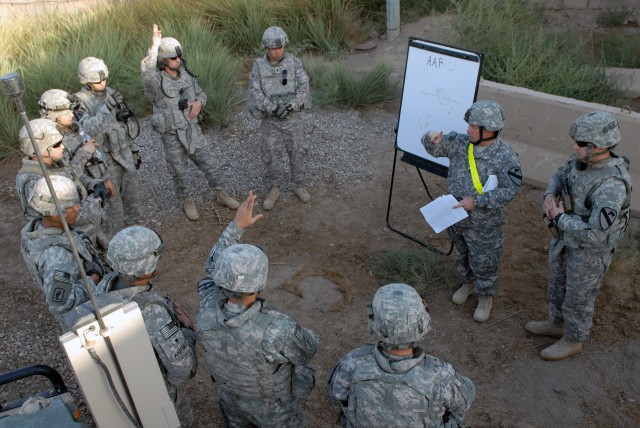BAGHDAD - Simulated machine gun fire blares over loudspeakers, Soldiers yell out commands and the opposition force attacks with RKG-3 grenades and small-arms fire.
Confusion reigns on the lanes at Camp Slayer, here, where instructors recreated a chaotic battlefield for Division Special Troops Battalion, 1st Cavalry Division Soldiers to train on different combat scenarios, Sept. 19-22, during a three-day exercise.
"There are many things that can happen on the battlefield and that can be perplexing for any leader," said Maj. Don Bottorff, the battalion operations officer who organized the training. "There's going to be hesitancy and some mistakes, but that's what this training is for."
Two different scenarios were created for the exercise. One simulated an explosively formed projectile attack and the other combined an RKG-3 grenade attack with an ambush.
"It becomes muscle memory reflex when you do something over and over again; it becomes second nature," added Bottorff. "Those precious few minutes [after the initial attack] could actually save Soldiers lives...If they're trained to do something then they're more apt to fight fluidly."
For Soldiers like Staff Sgt. Graham Rooney, a squad leader assigned to Battery E, 3rd Bn., 4th Air Defense Artillery Regiment, DSTB, 1st Cav. Div., the training is about being able to control initial reactions.
"The biggest thing is to take a breath and calm down," said Rooney, a native of West Palm Beach, Fla. "That's the hardest thing to train on - calming down and taking it one step at a time."
Though these Soldiers frequently travel the roads of Baghdad providing personal security escorts, they aren't engaged in combat every time, explained Rooney.
"It's not something that happens every day," said Rooney. "Doing operations and taking fire builds on our framework, which helps our proficiency."
Experiencing a complex attack from an insurgent force is something that these Soldiers have to be prepared for every time they leave the wire, said Sgt. Adam Nelson, a personal security detail member from Lansing, Mich., assigned to D Troop, DSTB, 1st Cav. Div.
"This training helps mental preparation for real-world events," added Nelson. "Confusion does set in for a minute. You gotta mentally prepare yourself before missions."
In preparation for every mission, Soldiers run through battle drills ensuring every member knows the location of the closest hospital, who is providing air security and what are the different radio frequencies of quick reaction forces in the area.
"When something goes down, it's kind of confusing," admitted Nelson. "I set a priority list...Security is number one and then I just go down my list."
"Tasks are multi-layered and there's a flow to them to get safely in and out of the kill zone," agreed Bottorff. "If mistakes are made in training, they can do it over again...before it becomes a crisis on the battlefield."
The concept behind putting more than 90 Soldiers through the training who have already been running combat missions in Iraq for more than six months is to take their abilities to the next level, added Bottorff.
"You have core individual skills and team skills that all come together in this training," said Bottorff, commenting on the teamwork and flexibility necessary to stay alive in dangerous circumstances.
"You're always adapting to the situation and tweaking things, you know, exchanging notes and seeing what works and what doesn't," said Rooney after he successfully navigated his convoy through an unfriendly mob of Soldiers posing as Iraqis.
After each scenario, the observers and controllers administered an after-action review of what went well and what could be improved.
"There are definitely things I'll take out of this training that I'll refine," said Nelson. "I'll take this training and go back and talk to my team leaders about what we can improve."
Most of the Soldiers agreed that the training succeeded in recreating chaos inherent in combat and that the experience helped them take their skills to the next level.










Social Sharing